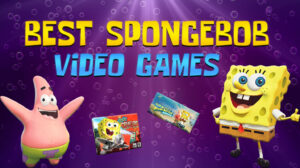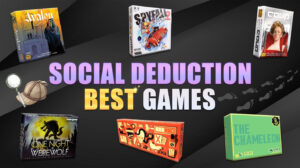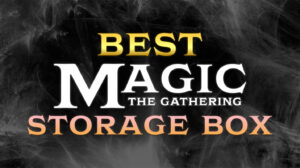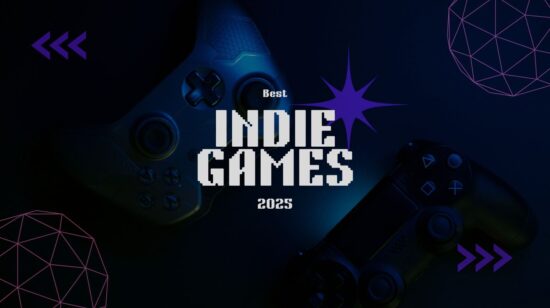13 Best Trading Card Games to Play in 2025
Eneba Hub contains affiliate links, which means we may earn a small commission if you make a purchase through them—at no extra cost to you. Learn more

The best trading card games aren’t just games – they’re entire worlds you can dive into. Deckbuilding, collecting, strategy, lore… it’s all here, whether you’re a newcomer or a seasoned player.
I’ve pulled together the most popular trading card games right now, from timeless hits like Magic and Pokémon to titles like Arkham Horror and Flesh and Blood. Some are rich in story, others are all about the grind.
Looking to collect, compete, or just crack a few packs? These top TCG games are actually worth your time (and money).
Jump to:
Our Top Picks for Trading Card Games
With so many card games out there, only a few managed to achieve real staying power and a loyal player base. These five are the ones I keep coming back to – whether for deck variety, competitive depth, or just pure fun. If you’re after smart design, collectibility, and long-term replay value, none of these picks will disappoint.
- Magic: The Gathering (1993) – Still the gold standard. MTG hits the fine balance between skill, luck, and strategy better than anything else. Deep mechanics, regular expansions, and endless formats keep it fresh after decades.
- Flesh and Blood (2019) – A modern standout that focuses entirely on competitive 1v1 dueling. No fluff – just clean, lethal gameplay that rewards tactical play and deep matchup knowledge. It’s built for tournament players, and it shows.
- Pokémon TCG (1996) – This one was surprisingly easy to pick up, but pretty deep once you dive in. With simple energy systems and a huge card pool, Pokémon offers both a relaxed entry point and a strong competitive scene. Great for kids and adults alike.
- Disney Lorcana (2023) – This newcomer brings gorgeous art, a creative resource system, and the power of Disney to the table. It’s family-friendly but with a real strategic bite. The demand has been sky-high, and I can definitely see why.
- Star Wars: Unlimited (2024) – A licensed TCG that actually plays like a real card game, not just fan service. It’s fast, flexible, and surprisingly deep, with smart deckbuilding and leader cards that shake up every match. Great flow, cool art, and way more replay value than I expected.
Each of these collectible card games does something unique for me, and they’ve all earned their place at the top.
13 Best Trading Card Games You’ll Keep Coming Back To
You’ve got classics that built the genre and newcomers shaking things up in the best ways.
Some reward deep strategy, others are just plain fun to collect and play. No matter your vibe, these are the best trading card games to get into right now.
1. Magic: The Gathering TCG

| Publisher | Wizards of the Coast |
| Core theme | Fantasy combat, spell-slinging chaos |
| Player count | 2+ |
| Typical game lengths | 10-60 minutes |
| Complexity level | High |
| Entry cost (approx.) | $30-$50 for a starter deck |
Magic: The Gathering is where it all began. If you’ve ever tapped a land for mana in other games, you’re standing in its shadow. It’s deep, brutal, and completely addictive once it sinks its claws in, which it will. It’s a complex game, so learning how to play Magic: The Gathering can take a while, but it’s absolutely worth it.
You build a deck before the match, but the real game starts when you draw that opening hand. Mana, creatures, spells, combos – every decision matters. One wrong move, and you’re on the back foot. One fortunate topdeck, and you’re back in it. It’s poker with dragons, chess with fireballs, and budgeting – but for goblins.
The real kicker? There’s no “best” deck. Just decks that are great right now, until the new best MTG cards for the format show up and the next meta shift nukes everything. Formats like Commander add social chaos, while Draft tests your instincts on the fly. It’s constantly evolving, and you’re never really “done.”
Why it’s worth playing:
You’ll curse your mana base. You’ll argue over rulings. You’ll spend too much money. And you’ll keep coming back. Magic is a lifestyle card game for people who want real complexity, mastery, and bragging rights.
2. Flesh and Blood TCG
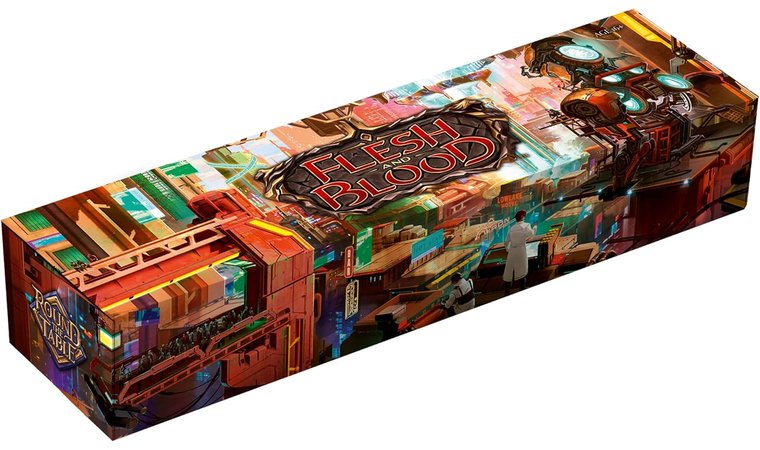
| Publisher | Legend Story Studios |
| Core theme | Weapon-based fantasy dueling |
| Player count | 2 |
| Typical game lengths | 20-50 minutes |
| Complexity level | High |
| Entry cost (approx.) | $15-$40 for a Blitz deck |
Flesh and Blood doesn’t mess around. It’s a one-on-one slugfest where every card in your hand is a weapon, a shield, or the stamina to pull off either. No flash, no planeswalkers – just two heroes locked in a tight, tactical brawl.
Decks are built pre-game around a hero and their loadout. You’ll attack, block, and manage resources in a system that feels like a real duel. Turns are fast but punishing. Play too aggressively and you’ll run out of steam. Play too safe and you’ll get steamrolled.
What sets FAB apart is its Pitch system – cards can be used for effects, defense, or to pay costs. That flexibility gives every hand weight. And the absence of traditional mana means you’re always playing the game. No land flood or dead turns, just pure, pressure-heavy interaction.
Why it’s worth playing:
If you’ve ever wanted Magic’s depth but with a stronger combat focus and zero downtime, this is it. FAB is for players who like tight mechanics, tactical decision-making, and earning every single win. Just be warned: it rewards skill, not luck.
3. Pokémon TCG
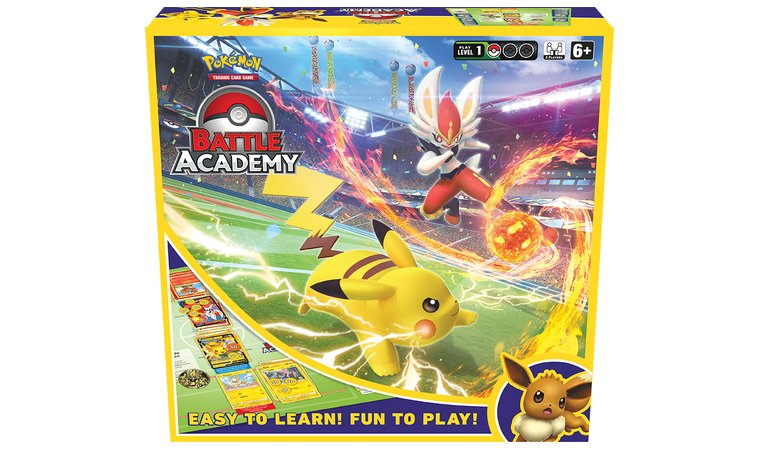
| Publisher | The Pokémon Company |
| Core theme | Pokémon battles and evolutions |
| Player count | 2 |
| Typical game lengths | 15-30 minutes |
| Complexity level | Medium |
| Entry cost (approx.) | $10-$30 for starter decks |
Don’t let the bright colors and friendly mascots fool you – the Pokémon TCG can hit harder than a Machamp on leg day. Beneath the surface-level cuteness lies a strategic battle of timing, tempo, and deck efficiency.
Each player builds a 60-card deck pre-game around a few core Pokémon, with trainers and energy cards thrown in for support. You evolve your ‘mons, manage your energy pool (basically a simplified mana system), and try to take all your prize cards by knocking out the opponent’s team.
It shares a lot with Magic – strong deck identity, evolving metas, tough resource decisions, and top Pokémon sets you’ll want to hunt for. But it’s faster, lighter, and friendlier for casual players. The prize card mechanic adds a nice pacing twist, too: every KO brings you closer to victory, so trading blows becomes a real calculation.
The digital version makes it easy to try different decks without spending a fortune, and the physical game has a huge player base and regular expansions. Just beware: it looks accessible, but building a top-tier meta deck is still a serious game. You can start with our great Pokémon card guide, where you can learn more about strong cards and their mechanics.
Why it’s worth playing:
Pokémon TCG is perfect for players who want strategic deck play without drowning in rules. It’s smoother, quicker, and a bit more forgiving than Magic, but still has room for big-brain plays.
4. Ravensburger Disney Lorcana TCG
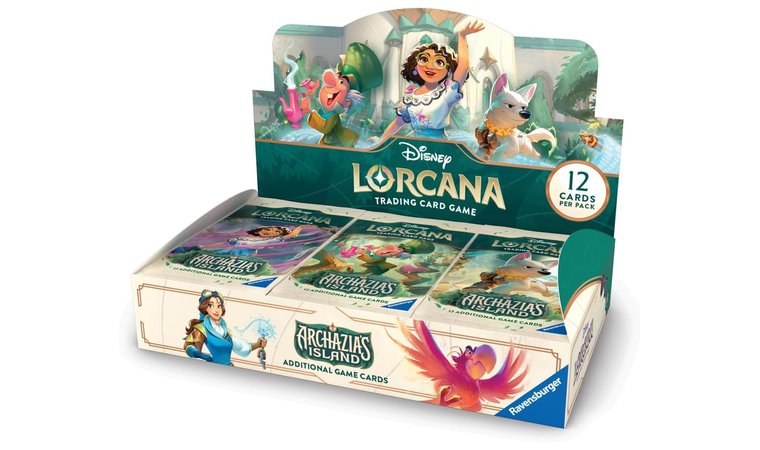
| Publisher | Ravensburger |
| Core theme | Disney heroes and villains reimagined |
| Player count | 2 |
| Typical game lengths | 20-30 minutes |
| Complexity level | Medium |
| Entry cost (approx.) | $15-$40 for starter decks |
Disney Lorcana might sound like a cash-in, but it’s a proper trading card game, and surprisingly solid. You’re not just throwing Mickey and Elsa onto a mat and calling it strategy. Lorcana borrows smart ideas from games like Magic and Hearthstone, wraps them in storybook polish, and keeps things fast, fun, and accessible.
Each player assembles a 60-card deck around “glimmers” – characters from Disney’s deep vault, reimagined with alternate art and abilities. Instead of knocking out your opponent, your goal is to collect 20 lore points by questing with your characters. It’s a race, not a brawl, but that makes tempo, board control, and card advantage feel refreshingly different.
Resources come from almost any card in your hand. The system is called “inking,” and it’s one of Lorcana’s smartest design choices. Instead of relying on separate resource cards like lands or energy, you can turn almost any card into ink. It makes bad hands less brutal and cuts down on dead draws.
The combat is light but strategic, with clever card synergies and solid deck archetypes already forming in the early meta. Characters can challenge or quest, forcing you to choose between gaining victory points or controlling the board – a simple tradeoff that leads to surprisingly tense decisions.
Why it’s worth playing:
Lorcana is perfect if you want the strategy of a real TCG without the intimidation factor. It’s smooth, well-balanced, and packed with fan service – all without dumbing things down. Great for new players, Disney fans, or anyone tired of games that take themselves too seriously.
5. Star Wars: Unlimited TCG
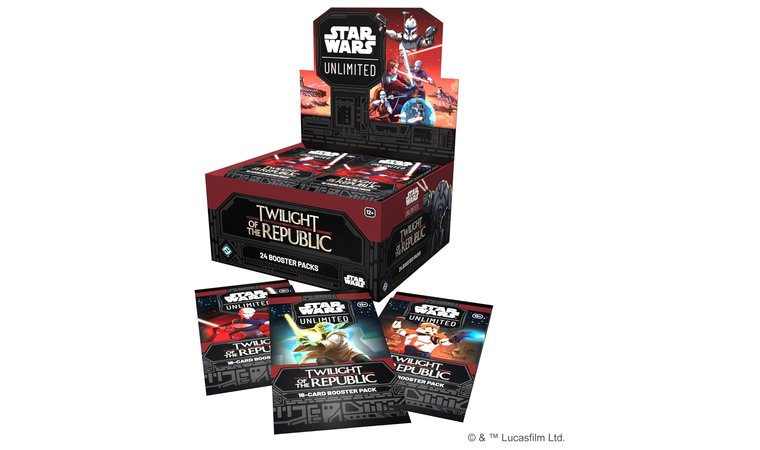
| Publisher | Fantasy Flight Games |
| Core theme | Fast-paced Star Wars battles |
| Player count | 2 |
| Typical game lengths | 25-40 minutes |
| Complexity level | Moderate |
| Entry cost (approx.) | ~$30 for a starter, $100+ for a full deck |
Star Wars: Unlimited is exactly what it sounds like – a streamlined, no-nonsense TCG built to bring the full scope of Star Wars battles to your table. Ground troops, starships, Jedi, bounty hunters, they all hit the board in a fast, modern format that doesn’t overcomplicate the fun.
Gameplay is split between ground and space arenas, and you’ll need to manage both. One-sided decks don’t last long. The action is initiative-based, with players taking turns performing single actions – play a card, attack, pass – which keeps momentum high and decisions constant.
Deckbuilding sticks to a leader + aspect system. Each leader (like Darth Vader or Luke) comes with a signature playstyle and a “ready” version that hits the board mid-game. Want to blitz down bases with Vader and a pile of red aggression cards? Go for it. Prefer blue-control Leia with shields and saboteurs? That works too.
Why it’s worth playing:
This is Fantasy Flight firing on all cylinders – slick design, strong IP synergy, and room to grow. It’s fast, aggressive, and built for a competitive scene. If you’re looking for a modern TCG that respects your time and still brings depth, this is the one to watch.
6. Equinox Altered: Beyond the Gates
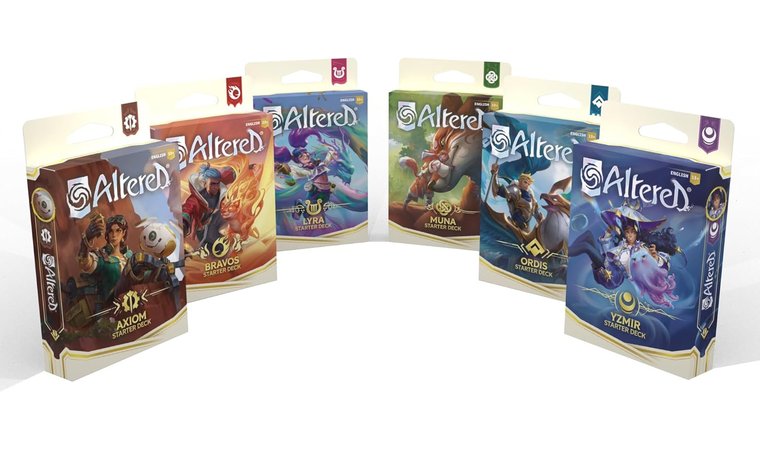
| Publisher | Planar Flux Games |
| Core theme | Multiverse duels, time fractures, alternate realities |
| Player count | 2-4 |
| Typical game lengths | 30-45 minutes |
| Complexity level | Medium |
| Entry cost (approx.) | ~$35 for core box |
Equinox Altered: Beyond the Gates drops you into a multiversal arena where fractured timelines and alternate selves collide. It’s a fast-paced, low-to-the-table game that blends tableau building, deck warping, and a bit of “wait, what just happened?” energy. Think Magic-meets-abstract strategy, with a big dose of quantum nonsense.
Each player represents a version of the same character from a different timeline. Your goal? Collapse the other timelines before yours is overwritten. Every card you play has two possible outcomes (labeled “This Timeline” and “That Timeline”), and flipping your choice mid-game is not only legal, it’s baked into the strategy. It messes with your opponent’s head and your own long-term plan, which is kind of the point.
There’s no mana, but there’s a clever resource system based on timeline stability – spend too fast and your deck warps; play too safe and you’ll get overrun. Combos feel satisfying without turning into math homework. And the art? Gorgeous cosmic-horror-meets-sci-fi dreamscapes.
Why it’s worth playing:
It’s rare to find a game that feels both brain-bending and breezy. Equinox Altered thrives in that tension. Smart mechanics, fast turns, and a genuinely cool theme make it a must-try for card game fans tired of traditional mana curves and lore bloat.
7. Transformers TCG: Bumblebee Vs. Megatron
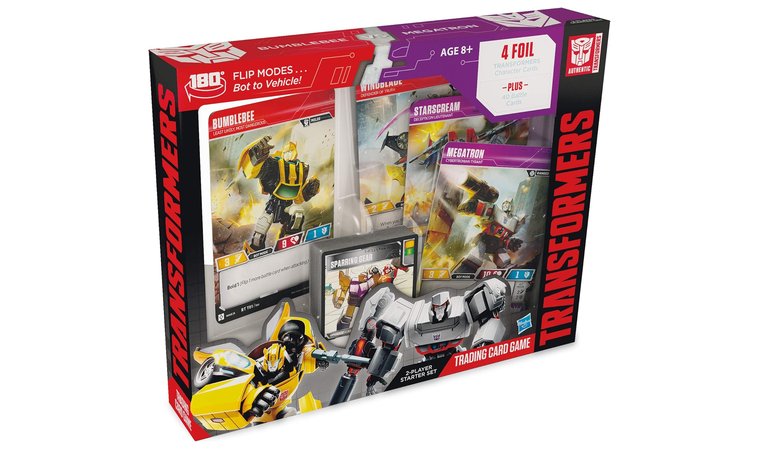
| Publisher | Wizards of the Coast |
| Core theme | Autobots vs Decepticons, transforming mech battles |
| Player count | 2 |
| Typical game lengths | 15-25 minutes |
| Complexity level | Low to medium |
| Entry cost (approx.) | ~$20 starter set |
This two-player starter pits Bumblebee and Megatron in a head-to-head smackdown that’s way punchier than you’d expect from a box that looks like a toy aisle impulse buy. Transformers TCG is long dead (Wizards shut it down in 2020), but Bumblebee Vs. Megatron still makes a great intro to what was a surprisingly solid dueling card game.
Each character is a chunky, foil oversized card that flips between robot and vehicle mode, giving you two sets of stats and abilities to play with. The flipping isn’t just for flavor; it’s a key part of your strategy, especially when timing attack boosts, armor swaps, and upgrade plays.
Gameplay is tight: attack with one character, draw and play upgrades, then flip your other bot and prepare for the counterstrike. There’s a light deck-building angle with Battle Cards, which act as gear, actions, and tricks. It’s fast, easy to teach, and crunchy enough to feel like a real casual game, not just Hasbro-brand fan service.
Why it’s worth playing:
It’s Transformers, but as a competent, combo-driven TCG that doesn’t waste your time. Bumblebee Vs. Megatron is still a great pickup duel box for casual nights or card gamers who just want to flip some robots and throw down. Plus, it still looks amazing on a shelf.
8. Chaotic: Trading Card Game
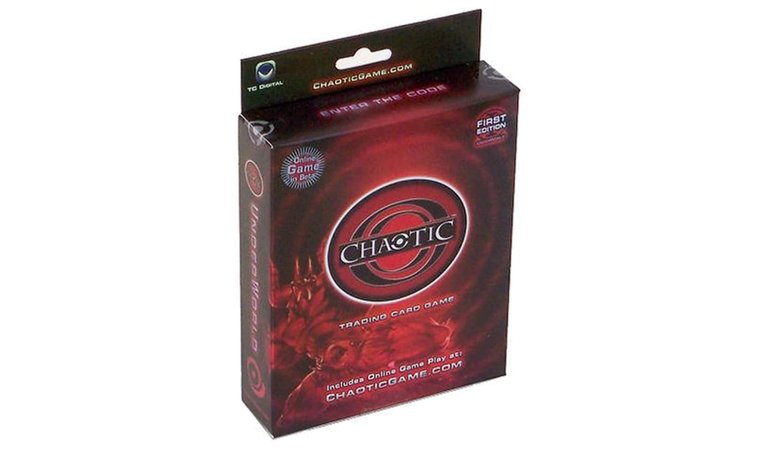
| Publishers | 4Kids Entertainment / TC Digital Games |
| Core theme | Monster battles, mixed with RPG stats and coded scanning |
| Player count | 2 |
| Typical game lengths | 30-45 minutes |
| Complexity level | Medium |
| Entry cost (approx.) | ~$30 for starter decks |
Chaotic was the early-2000s fever dream of card games – part Pokémon, part Yu-Gi-Oh!, part “scan this barcode into your Game Boy.” It came with an animated series, an online tie-in, and a ruleset that felt like someone tried to turn a monster-battling RPG into a competitive TCG. Somehow, it kind of worked.
The core loop has you fielding creatures from five tribes, each with their own gimmicks: overworlders, underworlders, bug-people, slime-things, and whatever else they cooked up in that lore blender. Each creature has actual RPG stats (strength, speed, courage) and can equip Mugic (yup, music magic) or artifacts to turn the tide in battle. Positioning matters, initiative matters, and yes, the dice do too.
It was clunky at times and wildly overcomplicated in places, but it had a unique rhythm: almost tactical, very stat-based, and with real weight to each creature’s loadout. The art was pure early-2000s energy, for better or worse.
Why it’s worth playing:
Chaotic is a broken gem. Beneath the weird names and barcode gimmicks is a deeply tactical card game that rewards smart positioning and loadout building. It’s not polished, but it’s got soul and enough wild ideas to make you wonder why no one’s brought it back properly. Lastly, if Yu-Gi-Oh! tops your list of TCGs, jump to the best Yu-Gi-Oh decks for meta and casual options.
9. Digimon Card Game

| Publisher | Bandai |
| Core theme | Digital monsters, evolution battles |
| Player count | 2 |
| Typical game lengths | 30-45 minutes |
| Complexity level | Medium |
| Entry cost (approx.) | ~$10-15 for starter decks |
The Digimon Card Game came out swinging with a bold goal: to bring back the energy of the early 2000s without the jank. Spoiler alert: it worked. This rebooted TCG balances nostalgia and tight gameplay better than it has any right to.
Instead of traditional mana or energy cards, you get the Memory Gauge, a shared resource system that adds constant push-pull tension. Overspend and your opponent starts their turn with a major advantage. Play it safe, and you might miss your chance to evolve into a powerhouse like WarGreymon.
Digivolution is the core loop here. You start with small rookie monsters and stack them up, gaining abilities and power as you climb. It’s fast-paced, tactical, and full of satisfying plays that let you swing the game in a single turn – if you’ve planned for it.
Deck archetypes are strong and flavorful, and the card art is consistently excellent. This game was made with love for the franchise and TCG mechanics.
Why it’s worth playing:
Whether you’re a returning Digimon fan or just want a smart, fresh TCG with slick tempo mechanics, this one’s worth your time. It’s easy to pick up, hard to master, and surprisingly deep – not just a nostalgia trip, but a real contender.
10. One Piece TCG
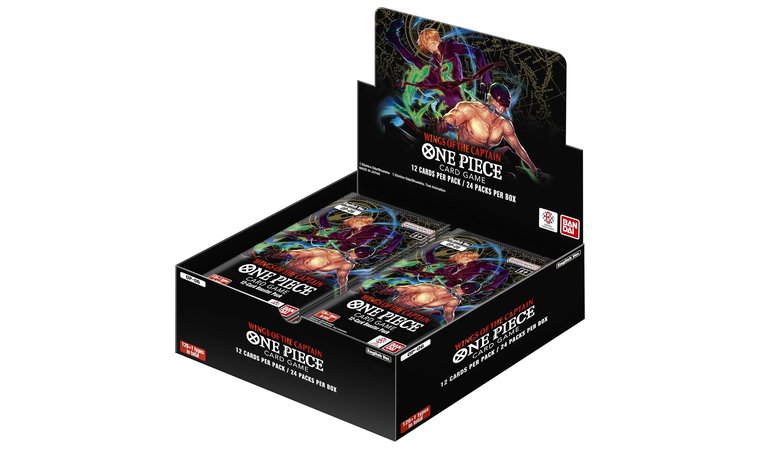
| Publisher | Bandai |
| Core theme | Pirates, alliances, epic battles |
| Player count | 2 |
| Typical game lengths | 30-45 minutes |
| Complexity level | Medium |
| Entry cost (approx.) | ~$12-20 for starter decks |
Like Star Wars: Unlimited, the One Piece Card Game is much more than a cash-in on a massive franchise. It’s a tight, clever TCG that manages to distill the chaos and camaraderie of One Piece into a fast-paced duel format. If you’ve ever wanted to see what would happen if Zoro went head-to-head with Crocodile under your command, now’s your chance.
You’ll pick a leader – basically your deck’s identity and playstyle – then build a 50-card deck around it. The gameplay revolves around Don!! cards, a shared resource you attach to characters and events. You can use them for boosts, plays, or tricksy counters mid-combat. It’s simple on paper, but there’s a ton of nuance once the match heats up.
Each color represents a different playstyle: red is aggressive, green rewards tempo, blue is control, and so on. There’s a solid meta forming already, but new sets keep shaking it up. The art is amazing, the card quality is high, and it’s surprisingly beginner-friendly despite being tournament-viable. Oh, and yes – there’s a ton of shouting.
Why it’s worth playing:
If you’re into One Piece, this is a no-brainer. If you’re not, it’s still one of the most energetic and well-designed TCGs out right now. Easy to learn, fun to pilot, and packed with character. It’s one of those titles that punch way above their weight.
11. Yu-Gi-Oh! TCG
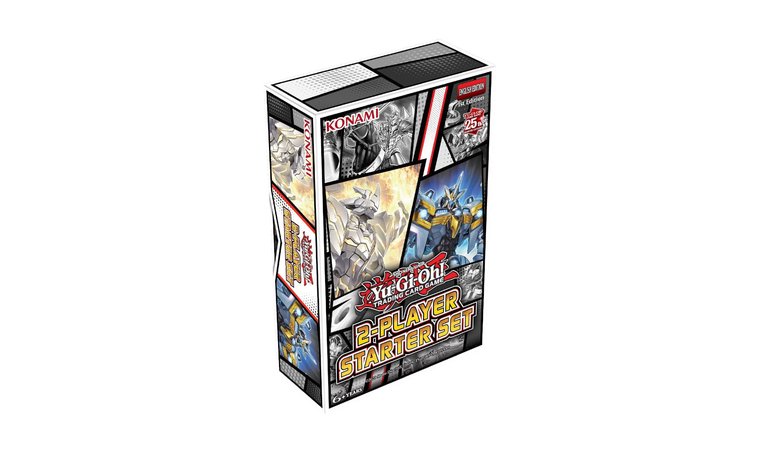
| Publisher | Konami |
| Core theme | Magic duels, summoning monsters |
| Player count | 2 |
| Typical game lengths | 20-40 minutes |
| Complexity level | High |
| Entry cost (approx.) | ~$10-15 for starter decks |
Yu-Gi-Oh! doesn’t do calm and collected. This game is pure, unfiltered card chaos, and that’s exactly why it’s lasted over two decades. If Magic: The Gathering is a fencing match, Yu-Gi-Oh! is a 12-hit anime combo with screaming, explosions, and trap cards you forgot existed.
You build a 40+ card deck (most go lean), then summon monsters, cast spells, and set traps. It’s fast, aggressive, and brutally punishing if you misstep. The real juice? The Extra Deck, packed with Fusion, Synchro, Xyz, and Link monsters that you can bust out for devastating plays.
The rules are dense and ever-evolving, with keywords stacked on keywords, but for players who love deep mechanics and explosive turns, there’s nothing like it. Every match is a puzzle, and once you know the system, you can chain plays like a pro.
New cards drop constantly, keeping the meta fresh. That also means power creep is real, but honestly, it’s part of the thrill.
Why it’s worth playing:
Yu-Gi-Oh! is a blast if you want deep strategy, big moments, and zero downtime. It rewards knowledge, creativity, and going completely over the top – in the best possible way. Just be ready to read a lot of card text.
12. MYA

| Publisher | MYA Cards LLC (independent) |
| Core theme | Dinosaurs, prehistoric flora/fauna, fossil science |
| Player count | 2 |
| Typical game lengths | 20-40 minutes |
| Complexity level | Medium |
| Entry cost (approx.) | ~$35 for Dawn of Hell Creek Starter Kit (aftermarket) |
MYA: Trading Card Game is what happens when someone looks at Magic: The Gathering and says, “Cool, but what if it were scientifically accurate and full of dinosaurs?” Set in the Hell Creek Formation right before the asteroid hits, it lets you build decks using real prehistoric species, plants, and geological events. No fireballs here, just tooth, claw, and the occasional extinction-level catastrophe.
Decks revolve around Active Entities (your dinos), Support Entities (like ancient flora), and a mix of Events and Effects that shape the ecosystem mid-duel. Positioning and timing matter. And pulling a rare mummified T. rex card? That definitely matters.
The production values are solid: thick cardstock, excellent paleo art, and rarities that actually feel collectible. It’s also educational, but not in the boring, worksheet way. It’s more like “Oh, I just learned what Sphaerotholus buchholtzae is while taking down a Ceratopsid.”
Why it’s worth playing:
MYA hits a rare sweet spot – it’s a functional, competitive TCG and a love letter to paleontology. If you’ve ever wanted to outmaneuver someone with an armored ankylosaur and then wipe the board with a volcanic ash event, give it a few rounds. It’s weirdly smart, deeply nerdy, and way cooler than you’d expect from a dinosaur card game.
13. Dragon Ball Super TCG

| Publisher | Fantasy Flight Games |
| Core theme | Samurai duels, politics, honor |
| Player count | 2 |
| Typical game lengths | 45-90 minutes |
| Complexity level | High |
| Entry cost (approx.) | ~$40 core set |
The Dragon Ball Super Card Game is exactly what you’d expect – fast, flashy, and full of screaming power-ups. If you’ve ever yelled “Kamehameha!” unironically, you’re already halfway in.
Each player leads a leader card, usually a beloved DB character that can awaken mid-game to power up. The rest of your deck builds around them, including combos, support characters, and wild, universe-breaking attacks. There’s a solid balance between raw offense and clever card timing, with a strong combo system that lets you dump cards from hand to buff attacks on the fly.
The energy system is a highlight. Any card can be played as energy, letting you ramp up quickly and keep plays coming. That means fewer dead draws and more time doing DBZ things like slapping Vegeta into the stratosphere.
I really liked the art and presentation, with cards that genuinely look like valuable collectibles. The competitive scene is thriving too, especially in North America and Asia.
Why it’s worth playing:
It’s Dragon Ball, only a bit smarter. The mechanics feel intuitive, the power curve is fun without being broken, and there’s enough depth for casual fans and serious duelists. It’s a great pick if you love explosive plays, deck synergy, and characters that scream louder as they get stronger.
What Makes a Trading Card Game (TCG)?
A Trading Card Game mixes strategic card play with the thrill of collecting. You build your own deck from a pool of cards – some common, some rare, and some you’ll trade three snacks for at your local game night. Ideally, you’ll win through better plays, stronger combos, and cleaner timing, but sometimes, you’ll just have a stronger deck.
Games like Magic: The Gathering or Flesh and Blood all follow this formula but twist it in different ways. Some lean hard into creature battles, others into bluffing or resource control. They also offer a bunch of different formats, each with its own meta and strategies. Think Standard, Draft, Commander, and Blitz, just to name a few.
You usually have to know your deck inside out, read the table, and get your timing right. But half the fun is in building your deck in the first place. We’re all trying to recreate that special feeling when we added our first rare to our very first MTG deck, and it felt amazing, even though it made it slightly worse, cause it didn’t fit, but we had a rare and had to use it.
With that out of the way, let’s check some of the main pillars of trading card games.
1. Collectibility & Rarity
Let’s be honest, the rush of cracking open a fresh booster pack is half the fun. Most TCGs are built around this randomness. You grab a pack, tear it open, and hope you just pulled something ridiculous. Sometimes you do and get crazy value, sometimes you pull a half-dollar crap rare. That’s the grind.
Cards come in rarity tiers like common, uncommon, rare, super rare, secret rare, foil-only unicorns, you get the idea. From mythics in MTG to top Scarlet and Violet cards in Pokémon, each game has its Holy Grails. The pull rate keeps things exciting, but it’s also what fuels the trading and collecting side of the hobby. Got extras? Trade with friends. Missing that one must-have card nobody has? Time to dig.
Starter decks are also a thing. The idea is to get a sealed, ready-to-play pile of cards that’ll show you the ropes. Once you get the basics, you’ll want more and inevitably fall into the rabbit hole of building your dream deck.
2. Deck Building & Customization
This is where the real magic happens. In most trading card games, you don’t just show up with a generic deck – you build your own from the ground up. You’ll pull from your personal collection, cherry-picking cards that work well together, support your game plan, and maybe throw in a spicy tech card just to mess with people.
You’re not just slapping random cards together. You’re building a strategy – an engine. If you prefer bleeding your opponent slowly over time, you’ll want a grindy control deck that needs a million turns to win. You can also go full aggro and win or lose by turn four. Fine-tuning your deck and researching options is just as fun as winning. If you want to make your deck meta-proof, some games like Magic have eternal formats with very few meta shifts.
Unless your entire crew netdecks, no two decks will be exactly alike. Even if you’re playing the same archetype, you might approach it from a different angle. Maybe you’re eyeing some top Pokémon cards from Lost Origins, and no one in your crew wants to explore that particular set. That level of freedom is what keeps people hooked for years. Deckbuilding is equal parts creative expression and ruthless optimization.
3. Strategic Gameplay
TCGs boil down to playing smart with the hand you’ve drawn. You try to manage your resources (mana, energy, ink) the best you can, play your cards efficiently, and get your engine going while disrupting your opponent as much as possible.
Your experience will depend on the type of deck you’re playing. If you’re creature-heavy, you’ll slam your beatsticks on the board and hope to God your opponent doesn’t have mass removal. If you prefer control, you’ll rely on reactive spells to keep you alive until your win-con can take over. Midrange decks do a bit of both.
Win conditions differ from game to game. It could be getting your opponent to zero life, completing a specific goal, getting enough of a certain resource, and more. Even within a single TCG, you can have multiple options. For example, in MTG, you can win by dealing enough damage to your opponent, decking them, putting 10 poison counters on them, or playing a card that simply says you win the game after meeting some difficult conditions.
Every match is a puzzle with many right answers. Correct plays depend on when and why, so the best TCGs will usually reward patience, foresight, and a bit of YOLO-ing once in a while.
4. Trading & Community
Trading is one of the main parts of the overall TCG experience. Before the Internet, it was also the only way to get the cards you needed for your deck. If you missed with your boosters, you had to trade with someone who pulled what you needed. Nowadays, you can also order singles online, so the trading aspect isn’t what it used to be, but it’s still very relevant.
You can also trade online through various marketplaces and forums. It’s still a huge part of the hobby. Trading can help you fine-tune your decks, complete sets, or grab a card you really like without opening a ton of packs. Trading cards you don’t need for something you want is also more efficient than spending money on singles.
Trading also builds community. It gets players talking, connecting, and helping each other grow collections. The best TCG scenes thrive on that interaction – deck talk, trade nights, friendly games, and the occasional brag about that shiny pull.
FAQs
What is the best trading card game?
Magic: The Gathering is the best card trading game. It offers thousands of cards for deckbuilding, many formats with different metas, including budget-friendly options like Pauper. There’s a massive community behind it and a thriving tournament scene.
What TCG is worth playing?
Magic: The Gathering, Flesh and Blood, Pokémon, Lorcana, and Star Wars: Unlimited are all worth your time. Each follows the tried-and-true TCG formula but also comes with its own twists and unique aspects.
What are the big 3 TCGs?
Magic: The Gathering, Pokémon TCG, and Yu-Gi-Oh! are the most popular trading card games. They’re still leading on the TCG scene in terms of players, complexity, and global reach.
What is the easiest TCG to learn?
Pokémon TCG is one of the most beginner-friendly card games. It has clean rules, the games are fast, and there’s a lot of official support for new players.
How many trading card games are there?
There are thousands of TCGs out there. Some are discontinued, a lot of them are probably not even that good, and some, like Magic: The Gathering, are still going strong after decades.
Are TCG games good for your brain?
Yes, TCGs can sharpen your memory, planning, and decision-making skills. Playing cards is a fun way of keeping your brain engaged, fighting stress, developing creativity and imagination, and it can also be a bridge to meaningful social connections.


